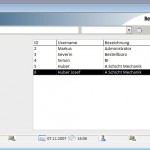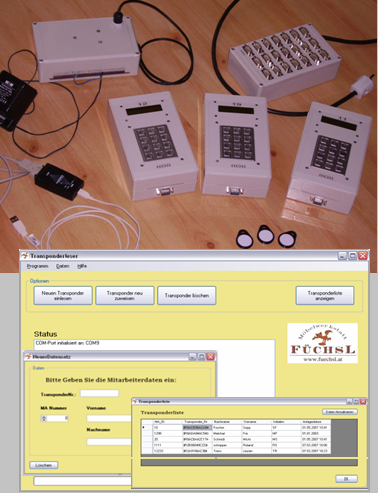2006 / 2007
Betriebsdatenermittlung Tischlerei Füchsl
Jahrgang
Projektpartner
Möbelwerkstatt Füchsl
Maturanten

Luger Thomas
5BI

Mitmasser Andreas
5BI
Betreuer

Wagner Christof

Felhofer Hubert
Problemstellung:
Es ist ein System aufzubauen, das in der Tischlerei Füchsl eine einfache Überwachung und Verrechnung der Arbeitsstunden an den verschiedenen Kostenstellen seiner Mitarbeiter ermöglicht. Dazu müssen so genannte Benutzerterminals installiert werden. Diese werten nach Anmeldung und Eingabe der Daten durch die Mitarbeiter, die benötigten Informationen aus und verarbeiten diese mit Hilfe eines Zentralrechners. Anschließend müssen die für die Kostenrechnung notwendigen Daten von der Software so aufbereitet und in einer Datei abgelegt, dass ein Benutzerverwaltungsprogramm diese auswerten und verarbeiten kann.Zielgruppe sind sämtliche Mitarbeiter im Bereich der Werkstätte sowie auch in der Buchhaltung, denen manuelles, aufwändiges Daten eintippen und lästiger Papierkram erspart bleiben und somit der Arbeitsalltag erleichtert und vereinfacht wird.
Zielsetzung:
Automatische Verarbeitung der Daten und anschließende Freischaltung der Maschinen in der Produktionswerkstätte in das Stromnetz.
Detail:
§ Ein Mitarbeiter, muss sich um eine Arbeit durchführen zu können auf einen der insgesamt 20 Terminals anmelden. Dabei müssen Daten wie Kostenstlle, Mitarbeiternummer und Auftragsnummer eingegeben bzw. mittels Transponder zwecks Mitarbieternummer eingelesen werden.
§ Diese Daten werden dann zum Zentralrechner gesendet, verarbeitet und überprüft.
§ Sind die Daten in Ordnung, wird von der programmierten und am Zentralcomputer installierten Sofware der zur Kostenstelle zugehörige Eingang der SPS geschaltet, sofern es sich um eine Maschinenkostenstelle handelt. Dies bewirkt die Freischaltung der Maschine ins Stromnetz. Nun kann die Maschine bis zum Ende der Tätigkeit benutzt werden. Dann muss sich der Mitarbeiter wieder abmelden oder an einer weiteren Kostenstelle anmelden, damit es zu einer Vollständigkeit der Daten kommt.
Ablauf:
§ Übergabe des Lastenheftes
§ Pflichtenhefterstellung / Präsentation für die Diplomarbeit – Einreichung
§ Auswahl, Bestellung der Hardwarekomponenten und Design des Aufbaus für Terminals
§ Zusammenbau eines Prototypen der Terminals
§ Programmierung der Softwareprogramme in C# / Microkontrollerprogramme in C
§ Zusammenbau der Terminals , Installation der Hardware im Betrieb
§ Fehlerbehebung / Verbesserungen
§ Dokumentation / Projekthandbucherstellung
Ergebnis:
Die Diplomarbeit wird im Zuge einer Maturaprojektpräsentation am Ende des Jahres an die Tischlerei Füchsl übergeben.
Verwertbarkeit:
Hauptnutzen für die Tischlerei Füchsl an diesem Projekt ist drastische Kosteneinsparung, da die aufwändige und umständliche, händische Eingabe der Aufzeichnungen, die die Mitarbeiter bisher machen mussten, zur Gänze entfällt. Mit diesem System ist die Betriebsdatenerfassung im Bezug auf Arbeitsstundenabrechnung und –Aufzeichnung vollautomatisch realisiert um eine lückenlose Datenerfassung der Arbeitszeiten an den Kostenstellen zu versichern.
Systembeschreibung:
Komponenten: Terminal, Zentralrechner, USB-CAN Modul, digitale USB-Schnittstelle
Sobald die Daten an einem Terminal durch Eingabe an der Tastatur bzw. Einlesen mit Hilfe eines Transponderlesers vollständig sind, werden diesen über einen CAN-Bus gesendet. Das USB-CAN Modul ist mit dem Zentralrechner verbunden, liest diese Nachrichten aus dem Bussystem und gibt sie an das Verwaltungsprogramm weiter. Nach der Verarbeitung der Nachrichten werden diese in einer Datei abgelegt, von wo sie anschließend vom Kostenrechnungsprogramm TOPAS ausgelsen werden können. Wenn die Eingaben einer Maschinenkostenstelle ensprechen, wird ein Befehl über eine digitale Schnittstelle an die SPS gesendet, um zu Signalisieren, dass die jeweilige Maschine elektrisch frei geschaltet und somit benutzt werden kann.
Presentation of the problem:
The main aim is to realise a system for logging data in a joinery which are needed for accountancy. In addition there will be a huge advantage because the monitoring and calculation of working hours in reference to the cost centres gets much easier. Therefore it will be necessary to assembly terminals which were installed in the production area.After the staff has themselves logged on and typed in data on the terminal, the information get sent to an main computer which processes them. The data have to be prepared and copied in a file by the software, that an extern administration program can analyse and apply them for cost calculation.The target group are the employees of the joinery in the production and accountancy area. For them the manual and time-consuming typing in of data and paperwork won’t be necessary any more and will be dropped out.
Objective:
Automatic processing of the data and the electrical enabling of the machines after it.
In detail:
§ At first the employee has to log on one of the 20 terminals, if he wants to do his work. In doing so he has to type in data as cost centres number and the order number. With the chip which he had logged on the employee number was read in.
§ These information get sent to a main computer which processes and checks them.
§ If the data are alright and the cost centre is a number of a machine the software gives an instruction to the SPS which displays that the electricity can be switched on for this cost centre. From now on the machine can be used. When he have finished he has to log off or change on another terminal the cost centre that the data will be complete.
Order of events:
§ delivery of the contract document
§ establish the acquirement specifications / presentation of the project – exhibition
§ choice, order of the hardware, design of the construction of the terminal
§ assembly of one prototype of one terminal
§ to programme the software in C#
§ install the hardware in the joinery, and assembly of the other terminals
§ error recovery / advancement
§ documentation / user guide writing
Result:
The project will be handed over to the project manager after the project presentation at the end of the year.
Usability:
The main advantage for the joinery Füchsl is that this system cuts down the accountancy costs and handling expenses tremendously. Because the employees haven’t to write down the working hours and furthermore the accountancy mustn’t type in the data in the computer any more. With this system it’s possible that the collection of data during a whole day works fully automated and there won’t be data incomplete or missing any more.
Description:
Components: terminal, main computer, USB-CAN module, digital USB-converter
If the data are complete at the terminal they will be sent over a CAN interface. The USB-CAN module is connected with the main computer and reads the messages out of the bus system. This data will be transferred to the administration program. After the data processing the information will be translated and gets memorized in a file by the software program. Subsequently the data set can be read out of the file from a staff managing program which is called TOPAS. If by the input on the terminal the cost centre number was equal to a production machine id, the main computer sends a command to the digital USB-converter which translates it to a signal that can be read in from an SPS. So the SPS system knew that the port of this machine can be switched on and connected with the electricity. Finally the employee can switch on the machine and use it.



